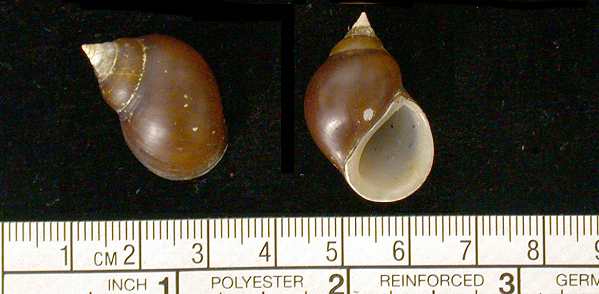
Data:
Could
you please help me identify this shell I find in the archaeological deposits
of Niah Cave, Sarawak, N. Borneo. I also find it living today in the lowland
freshwater streams just outside the cave. The identification of this will
help the imminent completion of my PhD thesis.
Send thoughts and
ideas to:
Mark Stephens BSc MSc
PhD candidate
Department of Geography
Royal Holloway
University of London
Egham, Surrey
TW20 0EX
UK
Email: Mark
Ideas:
-
Hmmm... looks like a cerithioid to me, possibly a member of Pleuroceratidae (or is it Pleuroceridae that is correct?), with its lack of a sharply-defined canal (pleuroceratids have a subtle spoutlike labral flexure for a canal); Thiaridae and Melanopsidae have sharply-defined canal.
Too big for any hydrobiid I know of... if he has any spares, I'd be interested, esp with operc! (and any other spp he comes across...). Not a viviparid (I think!) or ampullariid.
Andrew G. -
This looks more like a hydrobiid to me as there are several similar but much smaller shells from Thailand/Vietnam. - will need to chech litterature
Geoff M. -
The mystery shell from the Niah Cave and aquatic biotopes in Sarawak is a species of Paludomus (Fam. Pleuroceridae, suffamily Paludominae). Several species have been recorded from Borneo in general and Sarawak in particular: luteus H. Adams, 1874 (=moreleti Issel, 1874), isseli Brot (=crassus Issel,1874 not von dem Busch); persolida Issel, 1874 (=borneensis Nevill, 1884) and others.
Henk M. -
I have a specimen of Balanocochlis glandiformis (Schepman, 1896). It is similar in every respect, but a bit eroded on the spire. It came from near Sandakan, Sabah, Malaysia, in small stream on mud in rainforest, June 24, 1990, collected by Stephanie Clark. There is an image up at http://members.aol.com/Mkohl2/Pleuroceridae.html , but looking at the specimens in hand, they look much more like your excellent photos than the scans up on that page do.
Thank you for your interest,
Martin K.